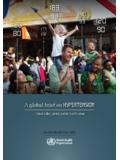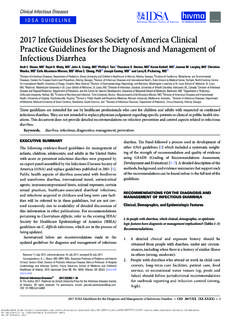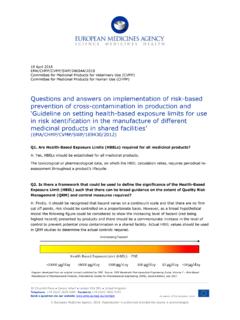Transcription of New ACC/AHA Guideline for the Prevention, …
1 Page 12 ISH Aw ar d Fu n din g Sch em e:Continued on next o Schi f f ri nPast Presi dent , ISHD epart ment of Medi ci ne, Jew i sh General Hospi t al ,McGi l l Uni versi t y, QC, CanadaNew ACC/ AHA Gui del i ne f or t he Prevent i on, Det ect i on, Eval uat i on and Management of Hi gh Bl ood Pressure i n Adul t sFourt een years af t er t he previ ous comprehensi ve US gui del i ne on management of hypert ensi on (JNC7), and 4 years af t er t he cont roversi al gui del i ne of t he 2014 Report f rom t he Panel Members appoi nt ed t o t he Ei ght h Joi nt Nat i onal Commi t t ee (JNC8 panel member report ), t he Ameri can Heart Associ at i on and t he Ameri can Col l ege of Cardi ol ogy have come out w i t h an ext ensi ve and novel gui del i ne f or management of hi gh bl ood pressure w hi ch w as present ed at t he AHA Sci ent i f i c Sessi ons on November 13, 2017 i n Anahei m, CA, USA.
2 It w as si mul t aneousl y publ i shed onl i ne i n t he Journal of t he Ameri can Col l ege of Cardi ol ogy and i n Hypert ensi on, j ournal of AHA, on t he same dat e. 1 Importantly, the recommendations in the Guideline are accompanied by Class of Recommendation and Level of Evidence applied to Clinical Strategies, Interventions, Treatments, or Diagnostic Testing in Patient major novelty of the Guideline is that f or the f irst time it modif ies the classical def inition of hypertension that used to be blood pressure (BP)?140/ 90 mm Hg. It proposes a category of Elevated blood pressure at a systolic BP (SBP) of 120 to 129 mm Hg. Subjects in this category need to undergo lif estyle changes to prevent progression of their condition to hypertension.
3 The new Guideline def ines hypertension as BP?130/ 80 mm Hg. At or above this level of BP, when conf irmed on a second occasion, individuals need treatment, which can include lif estyle modif ication or in cases of more elevated BP and greater cardiovascular risk in addition the use of antihypertensive medications. The change in the def inition of hypertension means that 46% of US adults are identif ied as having high BP, compared with 32% under the previous def inition according to US National Health and Nutrition Examination Survey (NHANES) The prevalence of hypertension was higher when def ined by the present 2017 ACC/ AHA guidelines compared to the JNC7 guidelines within all age, gender, race-ethnicity, and cardiovascular disease (CVD) risk is classif ied as stage 1 when BP is ?
4 130/ 80 but <140/ 90 mm Hg, conf irmed at a second visit. It is stage 2 when BP is measured ?140/ 90 mm Hg and conf irmed on a second the Guideline does not specif y whether BP should be measured with the auscultatory manual technique or with oscillometric devices, or the so-called automated of f ice blood pressure (AOBP), which may all give dif f erent results depending on how they are carried out, it does insist on a standardized and accurate BP measurement technique. It also emphasizes the need to use out of of f ice BP measurements, both ambulatory and home BP monitoring. The importance of diagnosing white coat hypertension and masked hypertension with out of of f ice measurements is underlined. Recommendations are given f or use of validated instruments and proper standardized technique to be used in not only in of f ice but also home BP measurements.
5 Since specif ic goals are given f or thresholds and target BP, it would have been critical to indicate how the BP levels indicated, such as 130/ 80 mm Hg, are to be obtained: with manual, oscillometric or AOBP measurements, since dif f erences between these may be important, with 10-20 mm Hg higher SBP in usual clinical measurements, if BP is not measured with unattended AOBP, which could result in overtreatment and harm. The controversy regarding the dif f erent techniques and lack of enough data on the exact dif f erence in BP results may be a reason why the Guideline committee did not aim f or the SPRINT goal of SBP<120 mm Hg, and settled f or a target SBP of <130 mm Hg f or most patients aiming to balance potential under and at the AHA Scientif ic Sessions on November 13, 2017 in Anaheim, CA, 13 ISH Aw ar d Fu n din g Sch em e:Continued on next EDITEDA nother important novelty is that specif ic recommendations are given regarding evaluation of global cardiovascular risk to guide management not only based on BP values.
6 Use of an atherosclerotic cardiovascular disease (ASCVD) ?risk calculator? (http:/ / ) to determine the patient?s risk of heart disease or stroke over the next 10 years is Elevated blood pressure, lif estyle modif ication is recommended. In the case of f ice BP is?120/ 80 mm Hg and masked hypertension is suspected, it is recommended that out of of f ice BP be evaluated. If out of of f ice BP?130/ 80 mm Hg, lif estyle modif ication should be continued and antihypertensive drugs those patients in stage 1 (BP at or above 130/ 80 but below 140/ 90 mm Hg) with no history of CVD or a cardiovascular risk over the next 10 years of less than 10% of suf f ering a cardiovascular event, lif estyle modif ication alone may be recommended and BP reassessed in 3-6 months.
7 If still ?130/ 80 mm Hg, antihypertensive drug therapy should be started. If on the other hand, the stage 1 patient has higher CV risk than 10% in 10 years, primary prevention of CVD requires introduction of antihypertensive drugs. Similarly, f or the patient with known clinical CVD, diabetes mellitus, or chronic kidney disease (CKD), secondary prevention requires lif estyle changes and BP lowering medication (1 medication). Patients should be reassessed in 1 month f or ef f ectiveness of medication therapy. If goal is met af ter 1 month, BP should be reassessed in 3-6 months. If goal is not met af ter 1 month, dif f erent medication or titration should be considered. Monthly f ollow-up should be continued until control is stage 2 patients (with BP?)
8 140/ 90 mm Hg), healthy lif estyle changes and antihypertensive medication (2 medications of dif f erent classes) are recommended, either as separate agents or as f ixed dose combination. Patients should be reassessed in 1 month f or ef f ectiveness, and if goal is met af ter 1 month, reassessed in 3-6 months. If goal is not met af ter 1 month, dif f erent medications or titration should be considered. Monthly f ollow-up should be pursued until control is achieved. If patients present with severe BP elevation?180/ 120 mm Hg, antihypertensive drug therapy should be initiated of treatment are BP <130/ 80 f or most hypertensive patients, including diabetic, CKD and elderly patients (unless the latter are institutionalized or wheelchair bound, or present orthostatic hypotension, syncope or f alls, in which cases individualized adjustment to less intensive treatment is reasonable).
9 This is a major change relative to previous recommendations and other guidelines that recommend target BP <140/ 90 f or diabetic and CKD patients. It should be noted that among the elderly who are recommended antihypertensive medication according to the 2017 ACC/ AHA Guideline thresholds but not those f rom the JNC7 Guideline , BP was lower but they had a higher mean 10-year CVD f or lif estyle modif ication include reducing salt and using the DASH diet and incorporating potassium-rich f oods, suggestions f or weight loss, smoking cessation, reducing alcohol intake and increasing physical ic recommendations are given f or choice of antihypertensive drugs, which include f irst line agents such as angiotensin converting enzyme inhibitors (ACEI), angiotensin receptor blockers (ARB), diuretics and calcium channel blockers (CCB).
10 Recommendations are given according to severity of BP and response to treatment, ethnicity and age, as well as presence of comorbidities (see below).Patients suf f ering f rom hypertensive urgencies (systolic BP >180 mm Hg and/ or DBP > 120 mm Hg) may be non-adherent to antihypertensive therapy. They also do not have new or worsening target organ damage. It is recommended in the Guideline that antihypertensive drug therapy be restarted or intensif ied, and anxiety, that of ten plays a role, treated. In hypertensive emergencies (systolic BP >180 mm Hg + target organ damage and/ or DBP >120 mm Hg + target organ damage), the Guideline recommends that the patient be admitted to an intensive care unit f or monitoring of BP and intravenous administration of appropriate antihypertensive agents if there is worsening target organ Guideline provides suggestions f or screening of secondary f orms of hypertension such as primary aldosteronism, renal artery stenosis, pheochromocytoma/ paraganglioma, etc.






